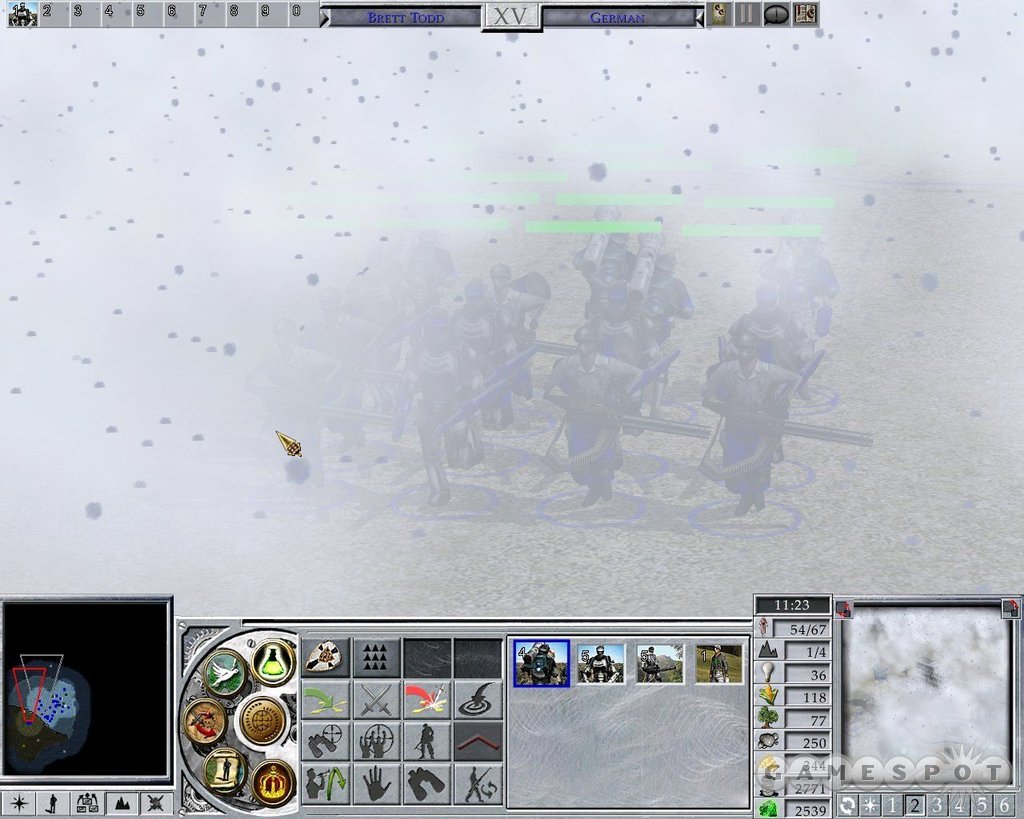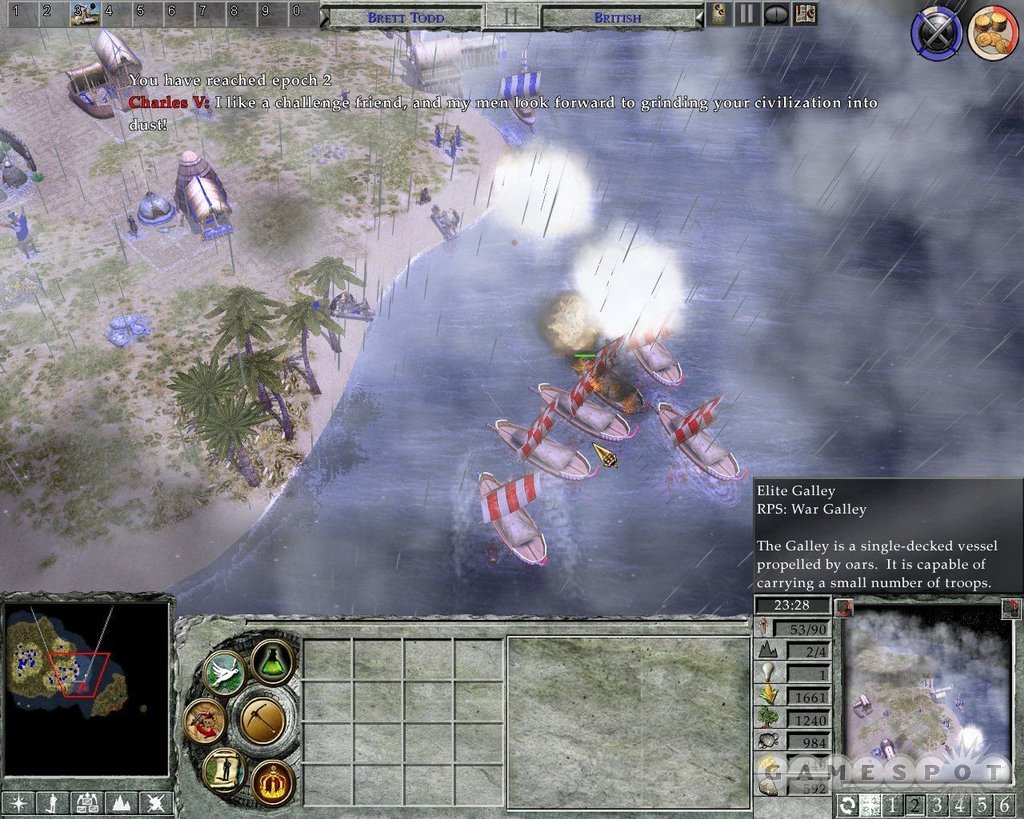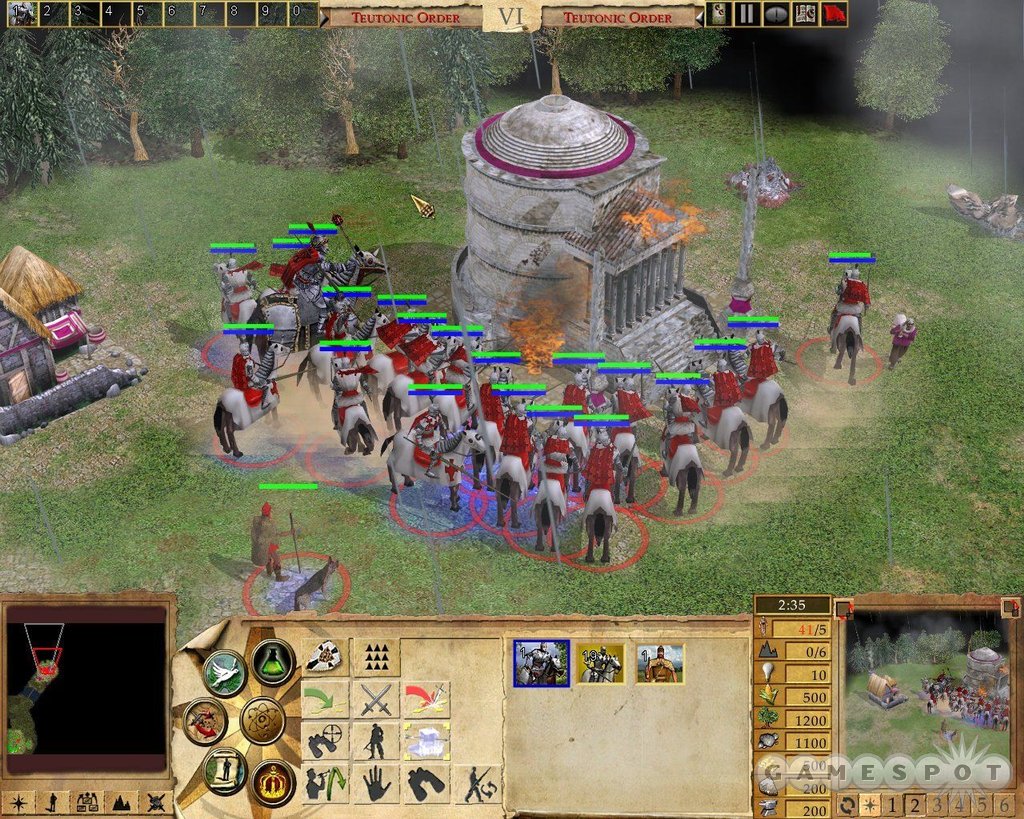Empire Earth II has a lot of good points, but it's no friend to the casual real-time strategy gamer. While developer Mad Doc Software has improved on Stainless Steel's 2001 blockbuster, increased depth and additional options have turned a huge game into an absolutely colossal one. This sequel remains a standard historical RTS, but it's also a grab bag crammed so full of new features, interface amenities, and complexities that it's bursting at the seams. Still, if you can commit a great many hours to familiarizing yourself with all the game's nooks and crannies, expect to be rewarded with an enjoyable addiction that will cost you weeks, if not months, of your life.

Thematically, this is the same old Empire Earth. Mad Doc hasn't strayed far from the adventurous formula of the original game. Half a million years of human achievement have once more been broken down into 15 epochs and 14 major civilizations representing all recorded history. Every step in human evolution is depicted. Resources are gathered, and armies are built on a truly epic scale. In the same game, you might see Neolithic tribesmen--one step removed from the Flinstones--gathering food and stones, as well as a future society that wages war with battle mechs that process uranium. Hundreds of buildings and military units are developed and deployed. Each epoch has its own tech tree featuring 12 items to be researched in military, commerce, and imperial categories. You can venture all the way from weaving to sentient artificial intelligence, from seasonal hunting groups to automated highways, and from tanning animal hides to nanomachines.
Game modes are standard for a historical RTS. A tutorial and three solo campaigns trace the development of the Aztecs, Koreans, Germans, and Americans from different points in the history of each civilization. Single-player "turning points" missions see you revisiting D-Day on either the American or German side, or fighting the ancient Chinese Three Kingdoms conflict on behalf of the Wu or Wei. Skirmish mode lets you set up online or offline battles between as many as 10 human and/or computer opponents in game types that feature nine different victory conditions.
In short, almost everything is where you left it. That said, the crucial word here is "almost." Mad Doc has introduced a number of interface tweaks in an attempt to make Empire Earth II more user-friendly than its predecessor. The new citizen-manager overlay screen, for example, shows resource piles and other locations, like universities where stragglers can be put to work. You can take in the entire map at a glance, check stats showing how many citizens are assigned to each resource pile, and organize those who have slipped through the cracks.
War planning has also received the one-stop-shopping treatment. When you want to coordinate an attack on a mutual enemy, all you have to do now is sketch out some circles and arrows in the war-plans applet and then send them to one or more allies for approval. This is a great boost to solo games, providing the illusion that you're fighting alongside human players. It also comes in handy in multiplayer games with real human opponents. Not only does war planning provide you with a ready way of discussing tactics, but also it enhances teamwork by making it so easy to draw up such battle plans. In fact, it makes it even more tempting to betray allies by sending them confusing tactics while simultaneously preparing underhanded offensives.

Picture-in-picture is another evolution of the interface, providing you with the ability to be in two places at once. It lets you both keep an eye on specified locales and manipulate units and buildings. Essentially, it works as a secondary game window. For example, when directing an army on the front lines in the main screen, you can observe your town and queue the production of units in the PIP. Up to six points of view can be bookmarked and then toured simply by hitting F1 through F6, making it a snap to move between town centers in larger games.
That's not entirely a good thing. Despite Mad Doc's good intentions, the PIP doesn't make Empire Earth II easier to play. If anything, it makes the game more complicated, as in both single-player scenarios and skirmishes against the computer, use of the PIP can lead to information overload. Since there are always a dozen or more tasks demanding your attention, it's too easy to get so caught up scanning from one hot spot to another, in addition to micromanaging, that missions can start to feel a lot like work. Games online now are more hardcore and unforgiving. If you want to really compete in multiplayer contests, you have to master the PIP, because odds are good there will be at least one multitasking guru in every game you join.

Gameplay itself seems to have received less attention in the design doc than the user interface. Not that this is a bad thing. The historical RTS template upon which Empire Earth II is based is solid in every way--save for clunky pathfinding, which remains a sore point in specific locations, especially at sea and when off-loading troops from ships--so it's a good thing Mad Doc stayed away from what wasn't broken.
There are a few key additions to gameplay. Roads can now be built to give units speed bonuses (although the benefit of this is dubious thanks to those pathfinding problems). Diplomatic options have been more fully fleshed out with the ability to barter territories in return for alliances. In both single-player and multiplayer matches, crowns are now awarded at timed intervals for successes in the military, economic, and imperial arenas. Lead the field militarily, for example, and you get to choose from a list of bonuses that increase damage done by your infantry for a limited period of time, add to the hit points of your naval vessels, and so forth.

A rock-paper-scissors formula remains the inflexible foundation of the game, but you can change just about everything else. A range of handicaps in skirmish mode run all the way from newbie to game god, adjusting core aspects of gameplay like unit production rate, tech-point generation, and inflicted damage. This nicely levels the playing field against human opponents online and allows for single-player skirmishes against computer antagonists of wildly varying ability. Game pace can also be adjusted, either with fast, slow, or medium presets, or by individually editing game functions. You can accommodate limited amounts of spare time with these speed settings, too. We cranked everything up and ripped through all 15 epochs in a couple of hours in one solo game.
Cunning artificial intelligence provides you with good competition no matter how you tweak the customization options. Computer enemies build their cities smartly, with well-thought-out fortifications. They set up outposts and walls, stud coastal areas with catapults, cannons, and missile launchers, and construct a hell of a lot of fortresses. Weak points are there to be exploited, but you have to scout or spy pretty hard to find them. So while there may be a beachhead in the enemy's rear that's perfect for the landing of an invading army, you usually have to endure the withering fire of a half-dozen surface-to-sea gun batteries to get there.
Attacks are carried out in an intelligent fashion as well. Computer opponents are aggressive, even on easy difficulty settings. They test your defenses in all areas and will only launch large-scale attacks at proven weak links. If computer armies are easily repelled from one locale a few times, you can virtually guarantee the next attack will focus elsewhere. Conversely, if an attack meets with even a modicum of success, you can bet more assaults will be directed at that particular location very shortly.
One area where Empire Earth II doesn't look so smart is in presentation values. The main problem is a certain sameness in units and buildings. Aside from individual soldiers and the handful of units particular to each civilization, buildings, ships, and aircraft have quite similar appearances in each epoch. This is a particular issue with related cultures, although it's noticeable with even the most dissimilar civilizations. So a game played as the Aztecs feels a fair bit like a game played as the Germans, or as the Chinese.

Even if you're not bothered by the somewhat generic feel of the game, the overall quality of the graphics and audio is a couple of years behind the times. Except for fantastic wind, rain, snow, and sand effects that seriously hamper visibility (or destroy it completely if the setting in video options is turned all the way up), whenever a storm rolls in, Empire Earth II doesn't look that much better than its 2001 predecessor. Unit animation is crude, and there's a lack of fine detail in general. The citizen-management and war-planner screens are extremely blocky and grainy, like photographs blown up far beyond their original sizes. Also, slowdown is an issue on maps with four or more players, even on systems with high-end video cards like the Nvidia 6800GT. During periods of inclement weather, the frame rate can drop so low that the game is barely playable.
Audio order acknowledgments are tedious and are repeated constantly. Some units have just a couple of response options, so you hear the likes of "Look lively, men!" and "Blood and iron!" over and over. Considering the amount of money VU Games obviously spent on this production, the number of voice samples is awfully chintzy. Music is more noteworthy, with different theme songs for each civilization. Some are even catchy, such as the Middle Eastern beat that accompanies campaigns played as the Babylonians. But again, there's too much repetition. The same few notes are recycled ad nauseam, so it isn't long before you're dialing down the volume or switching the music off.

Despite the negatives cited above, we can't fault Empire Earth II with anything but providing too much of a good thing. And when you look at just how much there is to experience, this seems like a pretty forgivable sin. A patient approach, perhaps coupled with the memorization of a dozen or so hotkeys, goes a long way toward appreciating this game, but the eventual payoff is definitely worth it.